Ecological Features of Terrestrial Insect Fauna of the Botanical Garden of Vasyl Stefanyk Precarpathian National University
DOI:
https://doi.org/10.15330/jpnu.8.4.52-60Keywords:
insects, fauna, botanical garden, biodiversity indices, trophic specializationAbstract
In 2018, we conducted a study of the terrestrial insect fauna of the Botanical Garden. Research was conducted at six areas: three areas in the meadow-steppe biotope, one area near a pond, and two areas in the forest part of the botanical garden.
As a result, 54 species of terrestrial insects were found to be inhabited, among which beetles from two families – Ground beetle and Darkling beetle (Coleoptera). The basis of the fauna of the botanical garden is widespread species (cosmopolitan, trans- and western Palearctic, trans- and western Eurasian, Scythian) – 88%; in most cases, these are evrybiont species that are well adapted to life in agrocenoses and in urbanized areas. The terrestrial insect fauna of the botanical garden is dominated by steppe and polyzonal species (57%), as well as a large share of field, steppe-field and meadow-field species (29%).
Comparing the species composition of insects in different areas, it can be noted that in the meadow areas of the botanical garden (Areas 2, 3, 6) there are no virgin species such as Amara pastica, Pterostichus macer, Taphoxenus gigas, and in the areas near the lake (Area 1) and in the forest part of the botanical garden (Areas 4-5) there are no field species Pterostichus punctulatus, Harpalus zabroides, Harpalus distringuendus, Silpha obscura; thus, the fauna of the meadow areas of the Botanical Chad is closer to the virgin steppe than the fauna of Areas 1, 4, 5.
56% of terrestrial insect species in the botanical garden are species with one or another degree of phytophagy, zoophagy is characteristic of 40% of species; pure phytophages make up 32% of species, pure zoophages 24%. Predominance of phytophages is a characteristic of agrocenoses and disturbed ecosystems.
One trend is observed – a decrease in the biodiversity of entomofauna in August; this is explained by the drying of biotopes at the end of summer, especially in 2018. If we compare the indices by biotopes, then in June biodiversity is much higher in the meadow areas of the botanical garden, and in August these indicators are slightly higher in the areas near the pond and in the forest part of the botanical garden, which can also be explained by environmental factors and their influence on terrestrial insect organisms.











